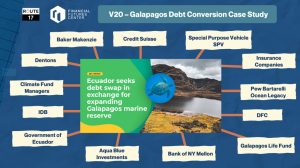There is now a consensus that climate change and climate change policy pose ‘macro-critical risks’ to national economies and the global economy as well. The frequency of climate-related disasters has increased by an order of five over 50 years, according to the World Meteorological Organization. Furthermore, transition risks emerge from a late and uncoordinated introduction of climate policies whose impacts cannot be fully anticipated by investors. This leads to sudden adjustments of asset prices, with implications on financial stability at the individual and systemic level.
The International Monetary Fund (IMF) has begun to build these concepts into its toolkit in order to help countries anticipate, prevent and mitigate these risks. One important tool that will need to incorporate climate risks is the IMF’s Debt Sustainability Analysis (DSA), which identify an IMF member state’s vulnerability to sovereign debt stress.
A new technical paper from Kevin P. Gallagher and Franco Maldonado for the Task Force on Climate, Development and the IMF focuses on the debt sustainability aspects of physical climate risk and the resource mobilization necessary for a transition to a more resilient and low-carbon economy. The authors experiment with the IMF’s current DSA methodology for Market Access Countries (MAC-DSA) to include estimates to physical and transition investments needed to prevent physical climate risk into the future.
The authors apply their methodology to two Andean countries: Colombia and Peru, both affected by climate-related disasters and will require significant resources to make a green transition.
Key findings:
- In these two test cases, climate shocks might significantly affect the countries’ public debt trajectory, making countries’ debt converge to a significantly higher level and, in some cases, increase the countries’ probability to incur in a stress event.
- There is a strong need for more robust, country-specific data that could be used as inputs into the MAC-DSA framework used by the IMF. The IMF will need to adapt these country-level applications for DSAs and beyond.
- Improved official data estimation is needed for the magnitude of investment required for resilience and low-carbon transition pathways in IMF member countries.




